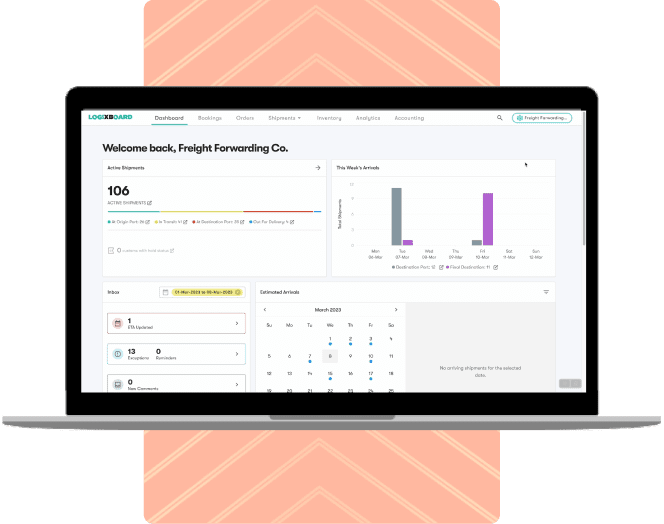In this article

THIS WEEK IN LOGISTICS
What we’re covering…
- How carriers and forwarders are finding sustainable supply chain goals faltering at the procurement stage ?
- This week’s featured news stories, including a new alliance of major shippers working to cut back on CO2 emissions ?
- FedEx planning to reduce flight hours this quarter due to continued low parcel and freight shipping demand ✈️
- Logixboard’s featured content and upcoming webinar ?
IN THE NEWS

Freight Companies Apprehensive Spending On Green Freight Transport
It’s 2023, and the industry is finally, collectively looking toward sustainability as a serious concern. Following the concept of encouraging green initiatives, governments too are looking toward legislation and rules to make eco-friendly the norm.
With efforts like zero-carbon emissions and reducing pollution through the use of EVs and autonomous vehicles, sustainability is soon becoming a major concern for all logistics and supply chain players as well. Freight operators, too, are rolling out a growing array of options for shippers looking to reduce pollution, from low-carbon aviation and marine fuels to electric trucks. Despite these efforts, carriers and forwarders are finding sustainable supply-chain goals faltering at the procurement stage itself.
TOP HITS THIS MONTH
Featured blog posts
LOGIXBOARD INSIDER
Want to check out the latest updates and releases at Logixboard? Drop by our LXB U: Open House ?
We’ll walk through live demos of our recent and upcoming product updates, from shipment visibility enhancements to CargoWise WriteBacks ?
Airing next Thursday, March 30th, at 10am and 4pm PST ?
- A new alliance of major shippers is pushing ocean carriers to step up their efforts to cut back on CO2 emissions. Zero Emission Maritime Buyers Alliance (Zemba), a partnership of shippers Amazon, Patagonia, and Tchibo with the Aspen Institute, are leveraging their collective buying power to speed up the shift to green fuel in ocean shipping.
- US Postal Service spends more on ground transport as it shifts away from air cargo. The US Postal Service increased its spending on trucks to move mail and packages between facilities as it shifted volume away from airplanes in the fiscal year 2022, advancing one piece of its long-term transformation plan.
- US Tariffs on metals and some Chinese goods resulted in raised American prices according to a report. US importers bore almost the entire burden of tariffs that President Donald Trump placed on more than $300 billion in Chinese goods, raising the cost of goods bought by American companies, a report by an independent US government agency found.
- The online freight booking platform Freightos expects 2023 revenue growth of 15% to 21%, down from a prior forecast of 87%. Freightos Ltd. is slashing its growth forecasts as sputtering cargo volumes and faltering freight rates take a toll on the shipping platform.
ON OUR RADAR
FedEx Planning To Reduce Flight Hours by Over 10% Due to Continued Low Demand
FedEx has been in the news for various business and strategy decisions. Now, the company plans to reduce flight hours by more than 10% and park more aircraft this quarter because of continued low demand for parcel and freight shipping. An 8% cut in aircraft utilization, sidelining nine cargo jets, and downsizing to smaller aircraft on certain routes helped the integrated express logistics provider generate $1.2 billion in year-over-year savings during the 2023 fiscal third quarter. The cost reductions, along with mass layoffs, offset 45% of total revenue declines, said CEO Raj Subramaniam during an earnings briefing.
The air and international unit was the major contributor to lower revenue and income at FedEx Corp. FedEx Express generated 8% less revenue and adjusted operating income plunged 81% year-over-year. To deal with this, the company is now focused on taking permanent costs out of the system and remaining on track to generate permanent savings of $1 billion this fiscal year. A more aggressive readjustment of the air network is a key part of this effort.
Additional steps to remove fixed expenses this quarter include the phase-out of the MD-11 fleet, which has served as flex capacity and leaning more on the FedEx Ground network for domestic parcel shipments. Nine MD-11s exited the fleet during the third quarter and six more are slated for retirement in the current quarter.
FedEx currently operates 58 of the older, tri-engine jets. Rival UPS recently indicated it has started to cull MD-11s in favor of more fuel-efficient aircraft. It recently completed the retirement of its last nine MD-10-30 freighters months earlier than originally planned. During the second quarter, FedEx scaled back international flight hours by 7% versus the prior year and domestic flight hours were 6% lower, officials said in December.
FedEx has 27 new 767 and six 777 freighters on order with Boeing for delivery in 2024 and 2025. In its 10-Q regulatory filing, FedEx said it would incur significant costs if it tried to delay the timing of new aircraft deliveries. FedEx last year launched a program called DRIVE that is designed to take out $4 billion in structural costs by the end of the fiscal year 2025, while also making the network more agile and flexible. Officials said they expect domestic and international express volumes to improve sequentially in the next couple of quarters.





